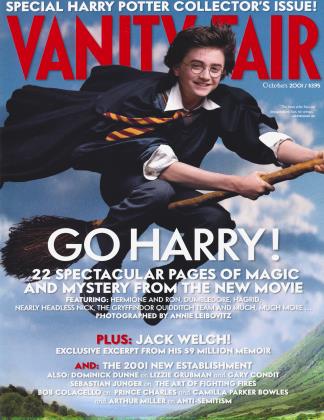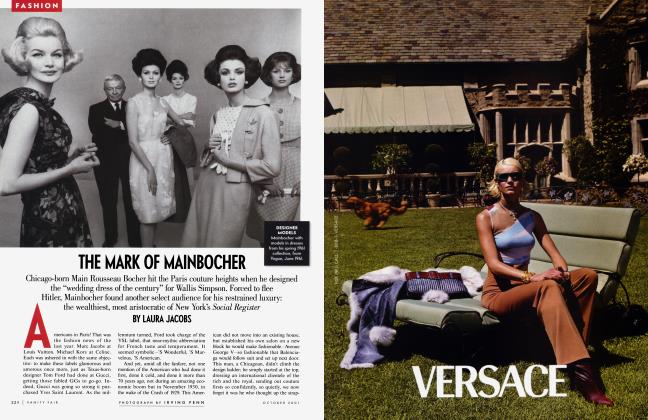Sign In to Your Account
Subscribers have complete access to the archive.
Sign In Not a Subscriber?Join NowCONTRIBUTORS
For special correspondent Bob Colacello, attending the round of dinner parties given by Prince Charles—his thank-you to the patrons of the Prince of Wales Foundation— was not at all what he had expected. “I thought it would be stodgy and square, and I was surprised at how stylish, relaxed, and even sort of hip the whole thing was,” says Colacello (left). “The setting was grand, but the attitude was not.” Contributing photographer Jonathan Becker was equally delighted by how trusting the Palace was in allowing him to “take pictures at both Buckingham Palace and Highgrove fairly untethered. It was unprecedented,” he says. “I was thrilled at the Prince’s generosity.”
It’s not danger in itself that interests contributing editor Sebastian Junger, but rather “the drama that surrounds things that are dangerous.” A point well illustrated by his two pieces in this month’s issue. The first is an article about forest-fire fighters— excerpted from his new collection, Fire—which is drawn from an earlier project on “dangerous work” in America. (Another part of that project, on commercial fishermen, went on to become the best-selling book The Perfect Storm.) Next is his report from Skopje, Macedonia, where he was exposed to a different kind of terror: a near coup outside his hotel window. “I’ve been in a number of war zones, but I’ve never seen a political or social crisis like that,” Junger says. “A crowd of 5,000 is really almost a force of nature.”
CONTINUED ON PAGE 104
CONTINUED FROM PAGE 96
During his 20 years as C.E.O. of General Electric, Jack Welch was the subject of innumerable articles and books. Now that he’s retiring, Welch, a native of Salem, Massachusetts, and the only son of an Irish-American railroad conductor, tells his side of the story in his memoir, Jack: Straight from the Gut, out now from Warner Books (which paid $7.1 million for the North American rights). “It was the hardest thing I’ve ever done,” says the man who turned G.E. into the most valuable and profitable company in the world. An excerpt begins on page 353.
Contributing editor Leslie Bennetts was introduced to the magical world of the Harry Potter books by her children, 12-year-old Emily and 9-year-old Nick (who has read each of the four books seven times and is the household’s resident expert). “They’re a wonderful read, not just for kids but for adults,” says Bennetts, who on page 300 previews the film, which will be released next month. “I know lots of grown-ups who are huge Harry Potter fans. I think the books are going to become real classics, as the Oz books have been for generations.”
While interviewing Jack Welch, the outgoing C.E.O. of General Electric, contributing editor David Margolick recalled a childhood ritual in which his family would watch the G.E. College Bowl every Sunday and compete, along with the two teams, in answering trivia questions.
He even remembered the commercials—all with jingles for G.E. products— and sang them to Welch.
As it turned out, Welch had no real recollection
of the program or the tunes. “It was a telling moment,” says Margolick, who profiles Welch on page 348. “I was more sentimental than he was. It was this lack of sentimentality that made him as successful in business as he has been.”
CONTINUED ON PAGE 108
CONTINUED FROM PAGE 104
Surrounding Paolo Zampolli with leggy, beautiful girls was hardly a conceptual stretch for photographer Walter Chin, who on page 344 captures the Italian president of ID Models. After all, Zampolli has built his name and career on legitimately picking up gorgeous women (it’s known in the industry as “scouting talent”) and signing them to his agency. “He’s charming for sure,” Chin says, “and he has exquisite taste in everything, even jewelry.” On the day of the shoot, the two formed a bond when Chin, an avid watch collector, complimented Zampolli on his Patek Philippe. “I have the same watch. I knew it cost as much as a Mercedes.” Chin’s first book, Work in Progress, was recently published by Stemmle.
Senior fashion market editor Mary F. Braeunig, who is
responsible for tracking down the clothes for celebrity shoots, compares her job to a scavenger hunt. “Whether digging through racks of vintage clothes or traveling to seasonal shows in Milan and Paris, I’m constantly looking for resources,” says Braeunig, whose search for, say, the perfect sequined royal-blue shirt can require a hundred phone calls. Never content to rely on a particular label or trend, Braeunig, a onetime seamstress, looks for pieces suited to the overall theme of the story. “It’s like a mini-movie,” she says. “We’re costuming the cast.”
This is the fourth year that editor-at-large Matt Tyrnauer has overseen the New Establishment, which was launched in 1995. “When we began the New Establishment, the dot-com revolution had not yet started, which provides insight into why it’s such an exciting project to work on—things change in a blink of an eye. Vanity Fair was barely on E-mail then,” Tyrnauer says. “The year we began the list Steve Case was No. 25; this year he’s No. 1.” From the team assigned to monitor the moguls’ deals and deeds throughout the year to the fat dossiers that are eventually produced, the reporting process, Tyrnauer says, “is not unlike an intelligence operation.”
CONTINUED ON PAGE 124
CONTINUED FROM PAGE 108
For editorial associate Heather Fink, the New Establishment, which starts on page 243, is a 12-month labor of love, sweat, and trivia. Fink’s herculean task: to track, analyze, and organize every telling detail, professional and personal, of the more than 50 moguls’ lives, compiling mammoth files that she, editor-at-large Matt Tyrnauer, and various writers transform into V.F.’s annual rankings. Now an Information Age connoisseur, Fink, 25, admits these pioneers have the allure of rock stars to her. After passing Steve Case on the street, the Connecticut native was starstruck. “I noted with interest that he was wearing a Hawaiian shirt. I know more about these people’s lives than is probably healthy!”
For renowned architect John Pawson, the collaboration between client and architect is a delicate thing. Especially when the client is a top fashion designer, such as Giorgio Armani. Pawson should know. He was commissioned by Calvin Klein for the designer’s flagship store— a minimalist temple on Madison Avenue. The collaboration of architect Tadao Ando and Armani for the Italian designer’s Armani Teatro in Milan, which Pawson writes about on page 328, achieved similar success. “In the Armani Teatro there is balance between creative encouragement and inspiration,” Pawson says. Pawson is currently at work on a Cistercian monastery in the Czech Republic. His cookbook, Living and Eating, will be published next month by Clarkson Potter.
Arthur Miller's writing career has spanned more than six decades, yet his work, which includes such theater classics as Death of a Salesman and The Crucible, remains as relevant as ever. In addition to The Crucible’s return to Broadway this winter, a film version of his 1945 novel, Focus, about antiSemitism in America, opens this month, prompting his thoughts on page 326. “The film—so many years since the novel was written—revived in me the America of the 40s. I was astonished at how effortlessly this movie could capture the era,” Miller says. His new book, On Politics and the Art of Acting, has just been published by Viking Penguin, and he is at work on a new play called Resurrection Blues.
 View Full Issue
View Full Issue






Subscribers have complete access to the archive.
Sign In Not a Subscriber?Join Now